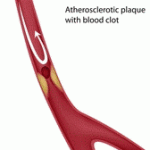There is no one simple test–some or all of the following procedures may be needed.
 These diagnostic procedures are used to establish coronary artery disease, to determine its extent and severity, and to rule out other possible causes of the symptoms.
These diagnostic procedures are used to establish coronary artery disease, to determine its extent and severity, and to rule out other possible causes of the symptoms.
After taking a careful medical history and doing a physical examination, the health professional may use some tests to see how advanced the coronary artery disease is.
The only certain way to diagnose and assess the extent of coronary artery disease is coronary angiography. Other tests can indicate a problem but do not show exactly where it is.
An examination for coronary artery disease may include the following tests:
- An electrocardiogram (ECG or EKG) is a graphic record of the electrical activity of the heart as it contracts and rests. Abnormal heartbeats and some areas of damage, inadequate blood flow, and heart enlargement can be detected on the records.
- A stress test (also called a treadmill test or exercise ECG) is used to record the heartbeat during exercise. This is done because some heart problems only show up when the heart is working hard. In the test, an ECG is done before, during, and after exercising on a treadmill; breathing rate and blood pressure may be measured as well.
- Exercise tests are useful but are not completely reliable; false positives (showing a problem where none exists) and false negatives (showing no problem when something is wrong) are fairly common.
- Nuclear scanning is sometimes used to show damaged areas of the heart and expose problems with the heart’s pumping action. A small amount of radioactive material is injected into a vein, usually in the arm. A scanning camera records the nuclear material that is taken up by heart muscle (healthy areas) or not taken up (damaged areas).
- Coronary angiography (or arteriography) is a test used to explore the coronary arteries. A fine tube (catheter) is put into an artery of an arm or leg and passed through the tube into the arteries of the heart. The heart and blood vessels are then filmed while the heart pumps.
The picture that is seen, called an angiogram or arteriogram, will show problems such as a blockage caused by atherosclerosis.
Coronary artery disease is treated in a number of ways, depending on the seriousness of the disease. For many people, coronary artery disease is managed with lifestyle changes and medications. Others with severe coronary artery disease may need surgery. In any case, once coronary artery disease develops, it requires lifelong management.
 Then you need to read this book, by New Zealand author, Dr. David Lovell-Smith.
Then you need to read this book, by New Zealand author, Dr. David Lovell-Smith.
In this book Dr. David Lovell-Smith describes how his patients successfully used diet, lifestyle changes and Transcendental Meditation to bring their blood pressure down.
This book offers new hope and insight for those with high blood pressure but it is not for hypertensives alone. The knowledge which Dr Lovell-Smith presents in his book is timely and relevant, and its exposition is long overdue.
Shop price is $34.95 Our price is $25.00 (including postage – NZ only)
